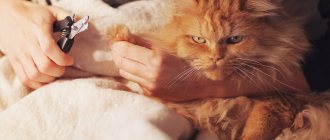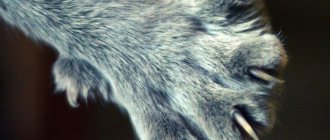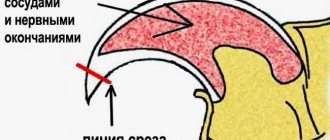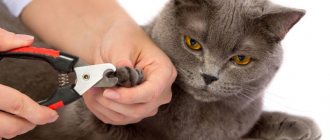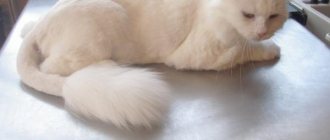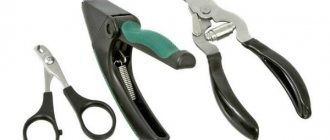The debate about whether it is worth trimming a cat's claws continues unabated. Some owners are categorical in their “no”, others defend the opposite point of view.
There can be many reasons for trimming the nails of your mustachioed and tailed pet:
- a cat injures a child with its claws,
- scratches furniture and wallpaper,
- brings back dirt on his claws from a walk, etc.
Yes, cats sharpen their claws on objects they like, and this is an important need for them - this way they grind off the overgrown part of the claw.
Cats can scratch a person playfully, and they do this not intentionally - this is a genetically determined behavior of cats.
So whether to cut or not to cut, each owner decides for himself, based on the possible risks.
Price for nail trimming
| Name of veterinary services | Unit | Price, rub |
| ⭐ Nail trimming | 1 animal | 300 |
| ⭐ Beak trimming | 1 animal | 300 |
| ⭐ Cleaning the anal glands | 1 animal | 300 |
| Hygienic cat grooming (with removal of mats) | 1 animal | 2000 |
| Sanitary animal grooming: | ||
| – small animals (up to 5 kg) | 1 animal | 1650 |
| – medium animals (over 5 kg to 15 kg) | 1 animal | 2750 |
| - large animals | 1 animal | 4400 |
| Sanitary washing of animals: | ||
| – small animals (up to 5 kg) | 1 animal | 550 |
| – medium animals (over 5 kg to 15 kg) | 1 animal | 3300 |
| - large animals | 1 animal | 5500 |
CLINIC REGISTRATION
HOME CALL
Properties of claws
You should start caring for a dog’s claws from an early age, while the pet is still a puppy, because its claws, although thin, are sharp: they can injure the bitch when feeding. And if the baby finds it uncomfortable to move due to overgrown claws, this will lead to incorrect placement of the paws or even dislocation.
Inside the claw of animals there is a pulp consisting of blood vessels and a bundle of nerves.
Important! Do not damage the pulp! This will cause your pet severe pain. If damage does occur, it is immediately noticeable - the claw bleeds.
How often should you cut your dog's nails? On average, paws need to be treated once a month. However, the frequency will vary depending on the conditions in which the pet lives. And if he often walks on the asphalt, the claws wear down on their own. If not, you can’t do without a haircut.
A reliable indicator that the time has come is the clicking of claws on the floor. This is a sign that your pet is uncomfortable walking. And there is no need to wait, succumbing to the fear of causing pain. Neglecting paw treatment has bad consequences.
What happens if you don't cut your hair? If you delay processing, they will become too long, sharp, and bent.
For a dog this means the following:
- the claw wounds the skin until it bleeds, in this case an infection can enter the animal’s body, there is a high risk of developing purulent inflammation, and this can lead to blood poisoning, tissue necrosis, after which - amputation of a finger or even the entire paw;
- with such wounds it is painful to move, the gait changes, and as a result, posture is disturbed, coordination is lost, and muscle tone decreases;
- the pet injures itself and upon contact may, unwittingly, injure adult owners or children;
- a much less serious drawback: the dog will damage the floor or furniture while trying to sharpen its claws.
Attention! When treating paws, we must not forget about the dewclaws: dogs often get caught on something with them, and this leads to injuries.
Since these toes do not touch the ground, it is difficult for your pet to grind down their claws.
How are the claws of cats and cats arranged?
A cat's claws are sickle-shaped for capturing prey, climbing trees, or defending itself during a fight. The part that we see is penetrated almost to the very tip with nerve endings and vessels, and at the tip there is a keratinized part that is constantly renewed. It is to renew it that cats sharpen their claws.
By cutting even a small section of a cat's claw, you can, without meaning to, hurt the animal and injure the claw. Don't forget that after using the toilet, cats scrabble after themselves, and improperly trimmed claws can become infected. Infected claws lose strength, peel and cause discomfort to cats.
A normal dog would never let his nails be cut.
As a rule, a dog can be accustomed to anything with a treat and a kind word. If possible, this should be done from puppyhood. “For very nervous comrades, there is this method: first take a regular comb and scratch the paws and claws, praise the dog if it does not pull its paw away, give it a treat. If the dog does not react to scratching in any way, except for glances in your direction, click the nail clipper next to the paw and praise again. After the dog begins to take this calmly, you can proceed directly to the haircut,” recommends groomer A. Gil.
When should you trim your cat's nails?
If the cat does not use scratching posts, and the stratum corneum does not wear off. Then the growing claws can interfere with the animal, clinging to furniture and carpets. In this case, the claw can be completely torn off. If the claw on the fifth finger grows, it becomes fused into the pad and injures it.
Also, claws may have abnormal growth and injure the pad of the toes in old or sick animals. Cats of such breeds as British, Persians, and Sphynx require special attention.
If you are going to cut the claws yourself, then you need to do this with special nail clippers for cats. At the same time, carry out “psychological” preparation of the animal: stroke your Murka’s paws, lightly press on her fingers - the claws will be exposed. Look carefully at the claw in the light, and you will see where the vessels end and its keratinized transparent part begins. So they cut it, retreating by 3-4 mm. from vessels. But this should not be done immediately, but after the animal gets used to the fact that you touch its paws and fingers.
It is not always possible to carry out the procedure on all fingers the first time. After the claws are trimmed, their tips need to be filed. Of course, it is better if you teach your cat to grind its claws down on its own using various devices (a small log covered with bark, a scratching post covered with a rough cloth, etc.)
If you decide to trim your cat’s claws, then at least for the first time go to a veterinarian, because this is not as harmless and simple a procedure as it might seem. In addition, cats do not like nail trimming and if you hurt them, they will stop trusting you. But these are full members of your family! Why do you need such conflict and negativity with your pets?
It’s another matter if the nail trimming procedure is carried out by a specialist in a veterinary clinic, using the necessary tools and professional skills that allow him not to touch the blood vessels and nerve endings during the procedure.
It’s better that your pet doesn’t like the veterinarian than you!)
Why trim your dog's nails?
Unlike cats, dogs do not use a scratching post to sharpen their nails. They wear down naturally when the dog runs a lot on hard surfaces and digs. Pets usually don't have the opportunity to run as much as their wild counterparts, so their nails don't wear down as quickly as wild dogs.
Long, unkempt nails are uncomfortable for your dog and can cause health problems. When long nails are constantly in contact with the surface on which the dog walks, pressure is created on the nail bed. For a dog, this is similar to the feeling when you wear shoes that are too tight. In addition, there is pressure on the finger joints. If a dog is left unkempt for a long time, it can lead to deformation of the joints and the paw will look flat and the toes will appear splayed. This changes the dog's body weight distribution, which can lead to other health problems. At a minimum, it becomes difficult and painful for the dog to walk and run.
In addition, long claws can simply break off and cause bleeding and pain. Wounds can become infected. In advanced cases, long claws can curl and grow into the paw.
Ungroomed long nails can cause discomfort and even pain for a dog. The more advanced the case, the more difficult it will be to trim the dog’s nails. This is because the dog will not allow the procedure to be carried out due to pain. Therefore, it is best to accustom your pet to regular manicures from childhood.
Popular cat haircuts
There are exhibition and home haircuts.
The following hairstyles are ideal for home use:
- lion - all hair is cut off except the head, the tip of the tail and the paws below the “knees” and “elbow”;
- puss in boots - in this case, hair is left on the head, tail and the entire surface of the limbs;
- summer
Exhibition or model hairstyles are created by experienced groomers.
There are many options for “laying”:
- continental,
- puma,
- harlequin,
- modern,
- the Dragon.
If your plans do not include a cat grooming or the animal stubbornly does not give in to the hairdresser’s onslaught, then you will have to monitor and care for the fur as usual:
- periodic combing;
- timely removal of matted hairs;
- the use of shampoos and conditioners that help soften and straighten the hairs.
Long-haired breeds must be given special products that dissolve mats in the stomach, or use ready-made food that already contains the necessary absorbable ingredients. And to prevent heat stroke, you will have to get an air conditioner.
Well, a video on the topic of how cats are cut in salons:
How much does it cost to trim nails at the vet?
Nail trimming will cost the dog owner from 300 rubles to 1500 . The cost of the dog envy procedure: the calmer the dog perceives the procedure, the cheaper the service will cost.
If sedatives or other assistance during manipulation are required, the cost increases accordingly to the price of the drugs and the time spent.
But the more often the haircut occurs, the faster the dog will get used to the manipulations, and the owner can trim the nails at home, spending money only to purchase the necessary equipment. Despite the fact that the tools are more expensive than a one-time nail trim (the cost of a good tool is about 10,000 rubles), the savings from the monthly procedure will quickly pay for the purchase of the tools.
Nail trimming is not a fad or a fashion statement, but a mandatory procedure for any dog, regardless of gender and size. A well-groomed pet not only pleases the owner, but also feels much better, pleases its owner with a perky disposition and good health. After all, it is always cheaper to prevent a problem than to treat your pet for a long time.
4.7 / 5 ( 3 voices)
What to do if the cat is not ready?
Trimming nails is not painful, but your pet may well be afraid of new things. Here everything depends on the relationship that develops between him and the owner. It is very important that the owner of a furry friend is kind, but persistent, and that the cat is in a calm state. During and before the procedure, you can start a conversation with your pet or pet it. And also we must not forget about precautions: antiseptics and cotton pads in case of injury.
With small-sized cats, of course, it’s easier, but the approach to them is exactly the same as with large ones. The violent method is not the best solution. If the animal is not in the mood or begins to resist, then it is better to leave the haircut until better times. This may take up to several days. But the pet will begin to trust.
The training process is very labor-intensive and requires patience. First, the cat must be trusted to hold the paw, then allowed to “expose” the claw, and then an unfamiliar tool in the hands of a person will cease to be dangerous and painful for him. It is better to develop a habit of this from a young age.
When first trying to do this, it is best to be accompanied by an assistant who will hold the four-legged animal. Breaks will undoubtedly be beneficial and improve the trusting relationship between the owner and his friend.
IMPORTANT! Nervous behavior: shouting and swearing will not lead to any good. Aggression from the owner will scare the cat. In the future, he will try to avoid getting a haircut by any means necessary.
How to train an adult cat to use a scratching post?
The situation is a little more complicated if the owner is faced with the problem of how to accustom an adult cat to a scratching post.
After all, you will have to somehow explain to the animal that you can no longer scratch the furniture or carpet, and draw its attention to a new unfamiliar object. To do this you need to arm yourself with perseverance and cunning. What should you pay attention to when choosing a scratching post?
What should you pay attention to when choosing a scratching post?
The first step is to choose the right drape so that your pet likes it. Several important details will help the owner choose the appropriate option:
- a cat’s favorite way to sharpen its claws (this can be one corner, a horizontal or vertical surface). Accordingly, the pet store selects a scratching post in the form of a column, rug or corner.
- stability of the drape - the ideal option would be a model with a heavy and wide base. After all, if she fidgets or suddenly falls under the weight of the cat, the animal will get scared, and this is unlikely to help in the question of how to accustom an adult cat to a scratching post.
Designs for sharpening cat claws are very diverse; a play complex with various platforms, shelves, tunnels and hanging toys would be an excellent choice. A scratching post with several tiers will be a favorite place for a cat, because here she will sleep, climbing higher, play and sharpen her claws. True, such a drape is not very cheap, but it will help keep your home interior intact and save money on buying new furniture.
Where to place the scratching post?
Initially, the most correct location for the claw grinder will be exactly the place that the cat has already liked to sharpen its claws. At first, the sofa or corner of the wall must be covered with something, or, if possible, the animal’s access to these places must be completely limited.
Draw your pet's attention in every possible way to such a new piece of furniture as a scratching post. How to train a cat to scratch it? First, call your pet to the drape or lure it with a game. Place the paws on the surface and gently press them so that the cat extends its claws into the upholstery material
Talk to her kindly, praise her, give her her favorite treat. The animal is unlikely to understand what’s what the first time, be patient and repeat this procedure several times a day. Every time your pet tries to scratch in the wrong place, pick him up and take him to the scratching post. Move the cat's paws along the drape again, tease with the toy to provoke it to release its claws into the upholstery. And reward the animal every time for the correct reaction.
Place the paws on the surface and gently press them so that the cat extends its claws into the upholstery material. Talk to her kindly, praise her, give her her favorite treat. The animal is unlikely to understand what’s what the first time, be patient and repeat this procedure several times a day. Every time your pet tries to scratch in the wrong place, pick him up and take him to the scratching post. Move the cat's paws along the drape again, tease with the toy to provoke it to release its claws into the upholstery. And reward the animal every time for the correct reaction.
Over time, when the problem of how to train a cat to sharpen its claws on a scratching post has been solved, and the correct habit has been developed, gradually move the drape to the place that you have previously thought up for it.
Best articles: Orders of the bird class - list, names, photos and brief description
If the house where the cat lives is quite large, then it is better to get several scratching posts and place them in different places. One of them should definitely be placed near the place where the pet sleeps or spends the most time.
How else to attract a cat's attention to the drapery?
If you still cannot cope with the dilemma of how to accustom your cat to a scratching post, try treating the catnip with catnip (catnip). Cats really like the smell of this plant - it is sold in pet stores, both in dry form and in sprays, and is used to attract animals. And the sharp smell of citrus fruits will help scare your pet away from the sofa or wallpaper. A few drops of lemon juice applied to favorite places to sharpen claws will keep your pet away from there for a long time.
The main thing in this matter is persistence and consistency, do not expect success the first time. Remember, you can achieve the desired result with a little patience and affection.
Tools and materials
Today, pet stores and veterinary pharmacies are not uncommon; there are even in remote villages. There you can buy all the necessary equipment and accessories for caring for cats. Specialists will select any tool and answer questions regarding nail trimming.
For a cat manicure you will need:
- claw cutter - guillotine or pruning type pliers, with sharply sharpened blades. A blunt instrument can hit special areas and cause pain;
- nail cutter - scissors similar to a manicure device, but made to resemble a cat’s claw;
- grinder - a device in the form of a ballpoint pen with a small rotating rod that grinds down the hard tissue of the claw at high speed;
- sanding file;
- hair clipper. If the pet has long hair, then the hair between the toes must be cut off. For animals that cannot stand the sound of a working device, fur can be removed using ordinary scissors;
- antiseptic and hemostatic agent (for example, hydrogen peroxide, iodine). May be useful in case of accidental damage to the soft part of the claw;
- baby talc - for sprinkling wounds;
- alcohol-containing solution - for cleaning instruments. Items for claw trimming must be disinfected before the procedure.
Important! You cannot trim a cat's claws with regular scissors or a human manicure tool. You can only use a nail file.
What not to do
It is also important to consider that some manipulations can be harmful to the health of the pet.
Do not do it:
- Place the cutting tool parallel to the nail plate, as this can lead to delamination.
- Skip the next manicure session.
- Trim an animal's claws if it is nervous, breaks out, or is aggressive. In such a situation, you can accidentally hurt or injure your pet.
- When pruning, do not touch the pulp, because bleeding and subsequent improper treatment can cause an inflammatory process.
- Carry out the procedure with blunt instruments. This is fraught with problems in the form of delamination or breaking of the claw.
- Plan several different activities related to pet hygiene for one day. This can negatively affect the cat's psychological health.
If a vessel is hit
If the cat gets nervous while trimming its nails and constantly tries to jerk its paw, a blood vessel may be damaged.
On a note! Having noticed blood on a claw, you should not panic and invent non-existent horrors - up to and including the development of gangrene in the animal.
Nothing like that will happen - the injury is equivalent to a small cut on a person.
If bleeding does not stop, contact your veterinarian
But it is necessary to prevent germs from getting into the wound - to do this, just rinse it with hydrogen peroxide or any alcohol-containing product. If the bleeding does not stop within 40-60 minutes, you should contact your veterinarian.
What to choose – trim or file your nails
Another option for treating claws is an electric file . The file used to process a dog's claw is no different from the one used to process human nails.
An electric file is a device with replaceable heads that, rotating quickly, grind down the claw. Compared to a nail clipper, a file is much less traumatic, but processing takes longer than with scissors.
In any case, even when using a nail clipper, it is necessary to file the sharp edge of a freshly cut claw to avoid its delamination.
What is required for the procedure?
Suitable tools are required to carry out the procedure correctly. Ordinary scissors will not work; you need to buy a special nail clipper. It is recommended to choose a tool carefully, taking into account the size and breed of the dog. It is worth paying attention to the following parameters:
- blade material – preferably brass or stainless steel, preferably with chrome plating;
- handles should be rubberized so that they do not slip;
- cast construction, fastened with reliable rivets;
- the tool should be comfortable to hold.
There are two types of nail clippers on sale. Secateurs that resemble scissors, only with a special blade shape. One of them is curved, the other is straight. Secateurs are convenient for small breeds; large dogs may not be able to handle the hard keratin layer.
A guillotine-type nail clipper is suitable for claws of any thickness. You just need to choose a tool that is suitable in size. This nail cutter consists of one blade with a hole. A claw is inserted into it and a lever-like handle is pressed. This is a professional tool, it is more difficult to use.
It is also recommended to purchase a file. With its help, they sharpen the claw, giving it the necessary shape, and smooth out irregularities. This helps prevent delamination. The file can be manual or electric. The machine is equipped with different attachments. If you choose a high-quality file, you can do without a nail clipper. Although many dogs are scared by the sound of an electric clipper, it also takes a lot of time to clean their nails with it.
Why does a cat bite its nails?
Sometimes you can witness how cats, like people, bite their nails. Often such actions are perceived as an element of self-care - the cat thus gets rid of the old stratum corneum - the so-called “case”. Or the nail has grown so much that it already causes discomfort and the cat gnaws it. Usually, the listed problems are easily solved by the cat on its own, by grinding its claws on furniture or other surfaces in the house. However, this may not be enough for pets. Here you will need the owner's help to trim your nails. There are also other, more serious reasons for this behavior in cats.
Paying attention to your pet's behavior is the key to its health
The first reason is being in a stressful situation. There can be many reasons for stress in an animal. This includes the appearance of a stranger in the house, a change in the usual environment, be it a move or a trip, and any violent actions towards the cat. At the same time, the animal may not understand the true meaning of actions directed towards it. These types of actions include: taking medications, washing the cat, treating wounds and other similar procedures. The point of these manipulations is to take care of the health of your four-legged pet.
Pets with free access to the street are no strangers to stressful situations - attacks from stray dogs, the chance of getting run over by a car, and simply the possibility of being harmed by people who can harm the animal. If you have not previously observed a cat biting its nails, you should analyze what possible events preceded this.
